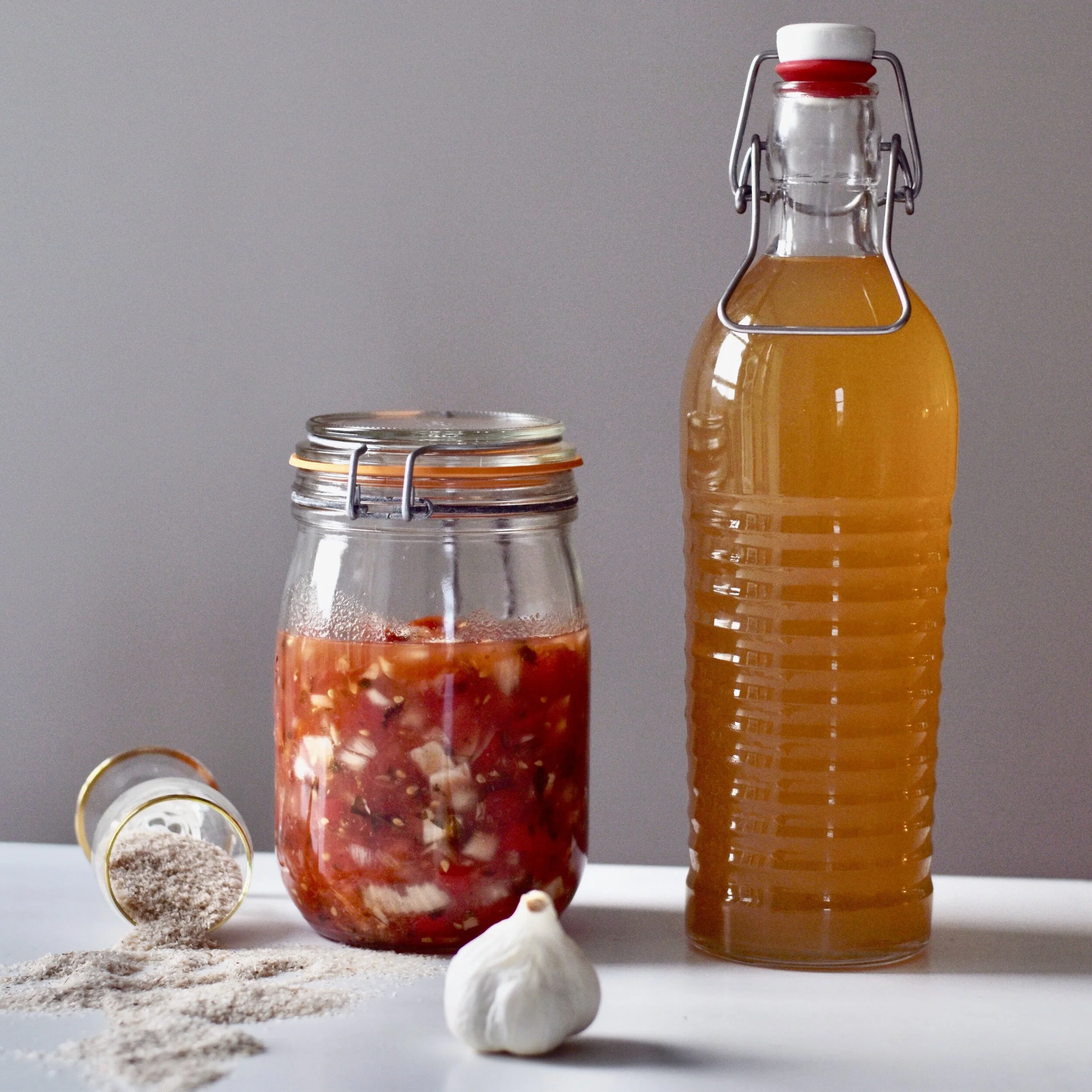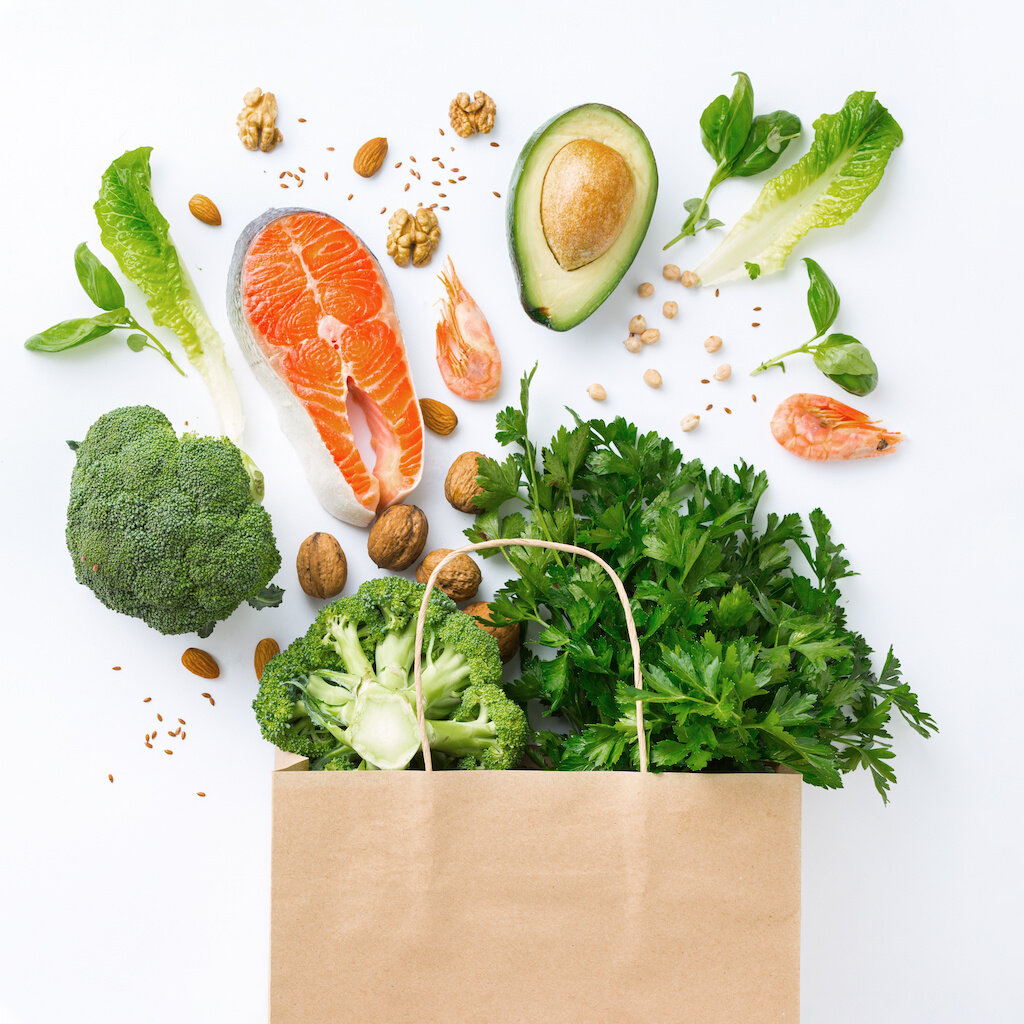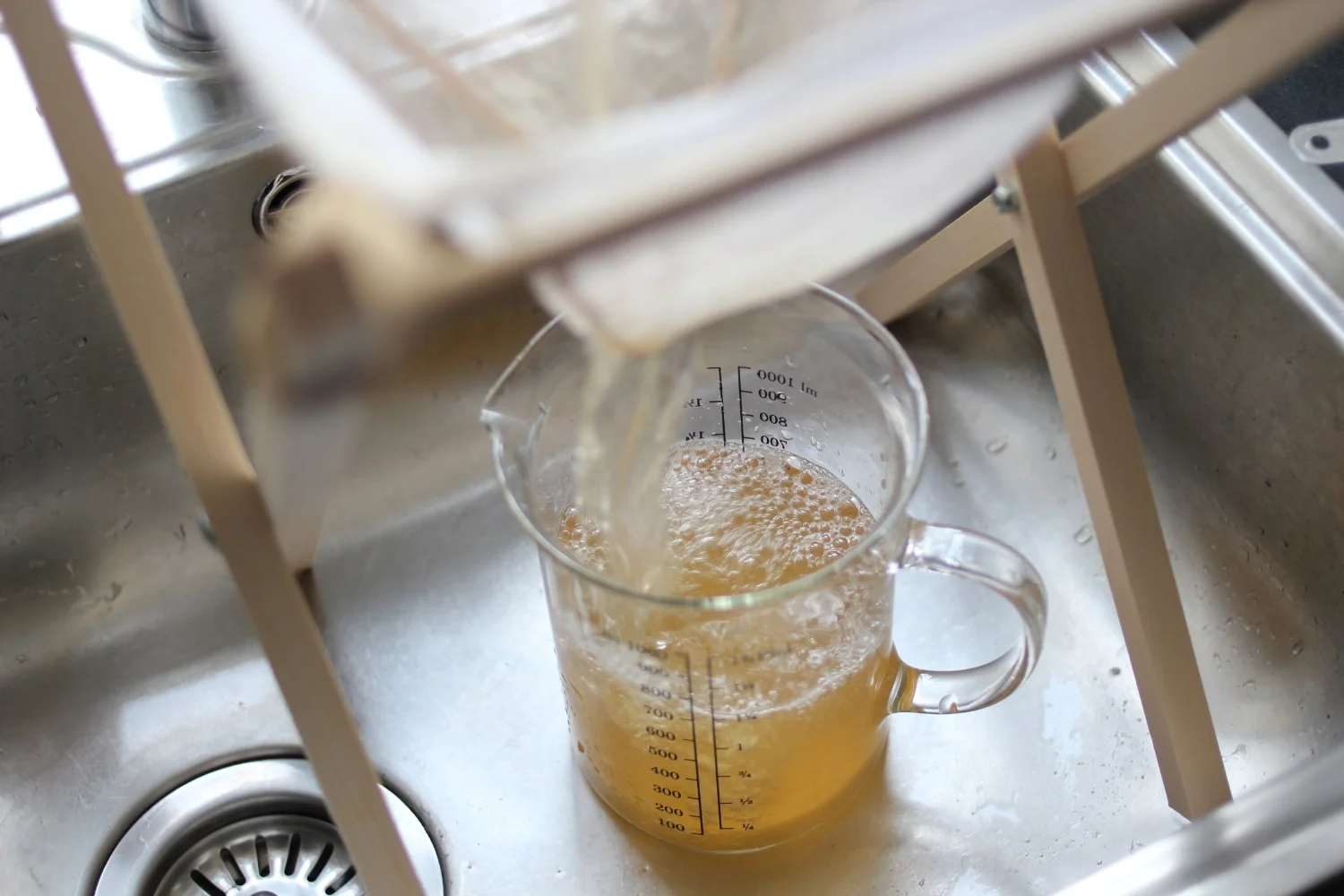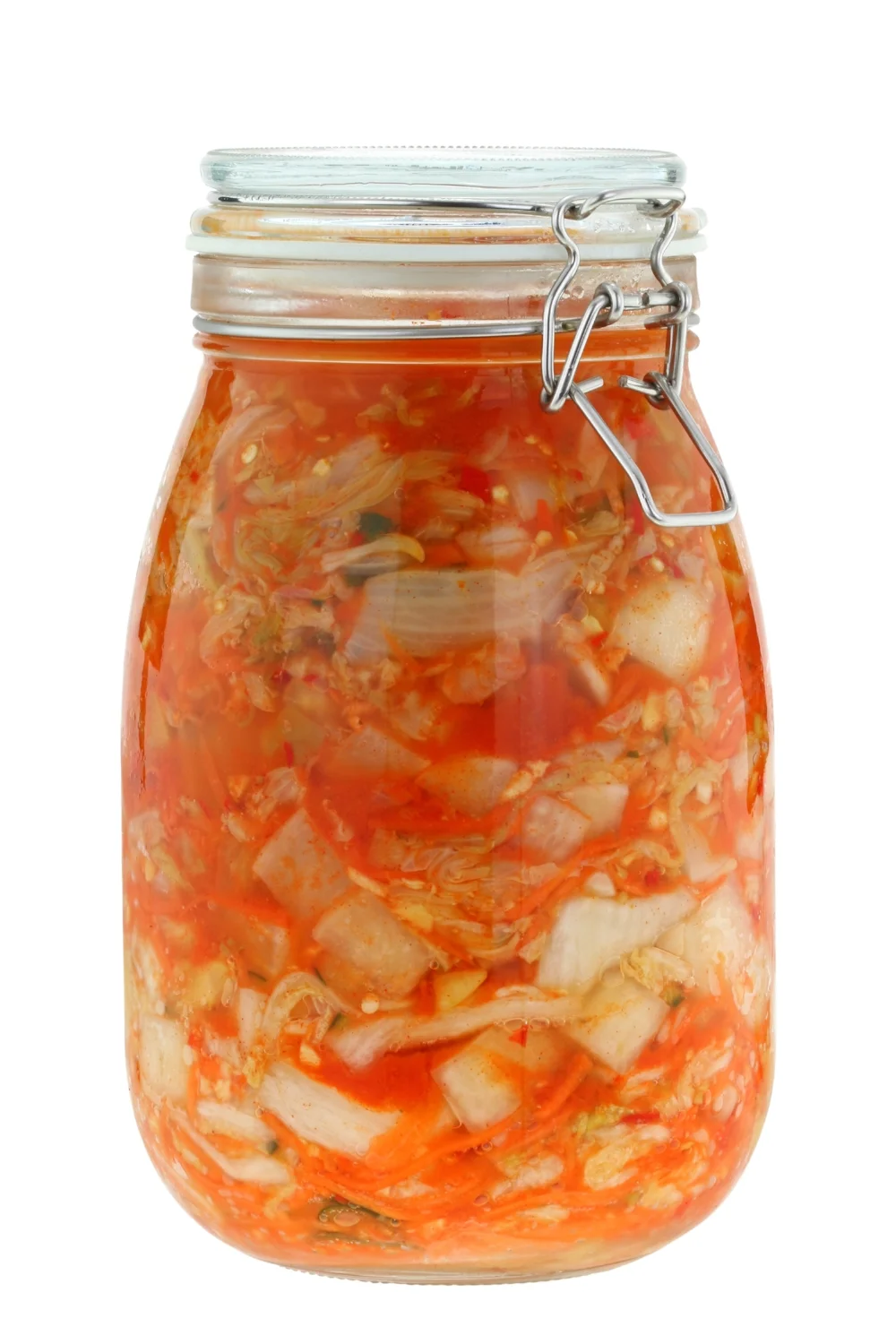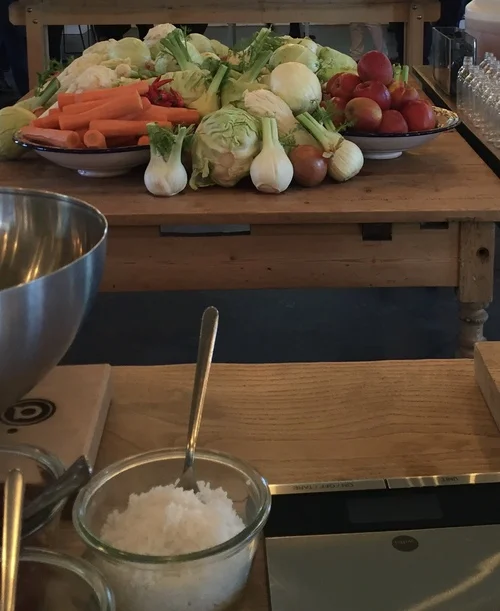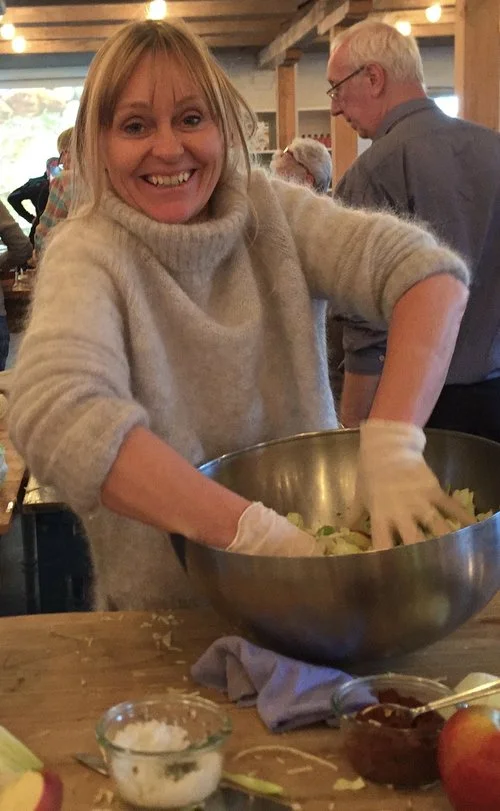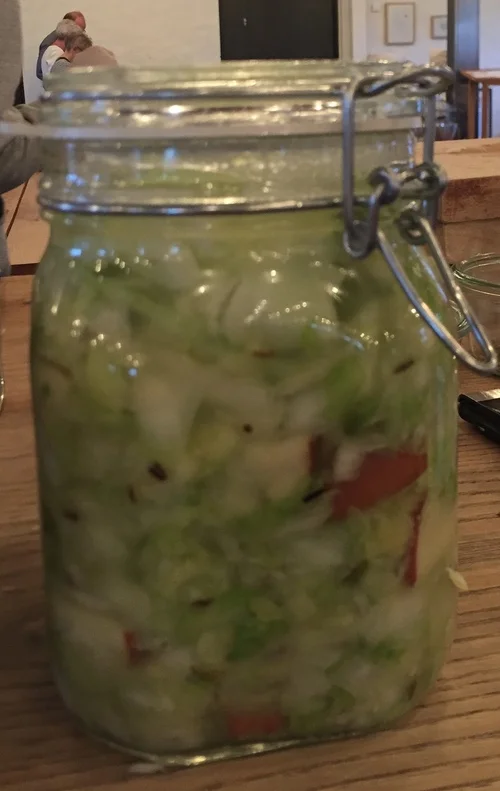Why The Secret To Your Health and Happiness Is In Your Micobiome
”Yes, you must kiss as many as possible in as many places as possible”. My friend Charlotte commented, as I turned to her with eyes as big as plates.
It was May 2016 and we were not at an introduction evening in a local swinger club, but at Krogerup Home Farm – Aarstidenes Farm Shop and Research Centre North of Copenhagen to an event about fermentation, and my world had just been turned upside down by lecturer Soren Ejlersen a Chef and the passionate Co-founder of Aarstiderne.com.
Me who for decades had tried to be an honorable girl. Me who readily have washed my home, myself and others with sanitizers, and preferably made food wearing gloves, was now sitting there sipping a microbe filled kombucha tea spiced up with fresh bark straight from a local ash tree - and was taught how important it is that we spread bacteria to each other and ourselves.
I participated in the event because I’d started to ferment for myself, but I was a little uncertain about my results so far, and given my phobia of bacteria I’ve thrown out the contents of several jars without even tasting it.
However here at Krogerup, where the importance of bacteria was the main message, my life long training in cleanliness was turned around.
"Does it have to smell that strange?" I asked Soren. The indulgent smiles on the faces of the microbe-loving gathering around me answered my question – I obviously didn’t have worry so much. It’s just those healthy bacteria that are working and multiplying.
Fermentation is about more than flavor or making fruit and vegetables last longer. Fermentation produces good bacteria - probiotics. Probiotics are vital, and help make us stronger, prettier and happier.
Contents
The vital bacteria
What are probiotics?
Bacteria and probiotics throughout history
9 health benefits of probiotics
Why you might lack good bacteria
4 Steps to Building Up Good Bacteria in the Digestive System
How to Choose the Best Probiotic Supplement
The 6 best natural sources of probiotics
Are there any probiotic side effects?
how to ferment – homemade natural probiotics
The Vital Bacteria
We are all colonies of microbes and we have lived together forever - us and the bacteria. Our skin and digestive system by themselves host about 2,000 different types of bacteria.
We have developed with bacteria for millennia, we transfer bacteria to each other, which make us stronger and the bacteria maintain many of our most vital functions - they let us digest food, maintain our immune system and maintain our intestinal flora, and the list goes on. Actually, there are more and more indications that a strong immune system.
“All disease begins in the gut
”
This post contains links to the products that I use myself or can recommend. If you buy products through these links, the price will be the same for you, and I will receive a small commission, which helps to support this blog. My affiliate policy.
What Are Probiotics?
A perfect microbiological world exists in every human being. Bacteria cover us; and most of these bacteria live in our gut and digestive tract. In fact, there are actually 10 times more probiotics in our gut than cells in our body!
Probiotics means "pro life" and is a supplement or food that contains live, well-defined microorganisms in sufficient numbers to change your intestinal flora. Every time we consume living fermented food or a probiotic supplement, we inoculate our gut with these beneficial bacteria.
The functions of these bacteria include strengthening digestion, supporting immune system, help fight infections, increase the body's ability to absorb nutrients, and they digest and ferment fiber into short-chain fatty acids that nourish the gut.
Probiotics come into our systems right at the moment we step into the world. When a newborn is in the birth canal of the mother during delivery, that’s when the baby is exposed to the bacteria of his or her mother for the first time. This event starts a chain of events inside the baby’s GI tract, and the infant’s GI tract starts to produce good bacteria.
If you don’t have enough probiotics, the side effects can include digestive disorders, skin issues, candida, autoimmune disease, and frequent colds and flus.
Bacteria And Probiotics Throughout History
Our early ancestors got lots of bacteria and natural probiotics, through the fresh foods they collected straight from the soil - and they didn’t clean and wash their food as thorough as we do today.
Later and for thousands of years humans have survived winters on stock of fermented food. The fermentation makes the product retains its vitamins, and also makes them easier for the intestine to absorb.
The era of fast and processed food put an end too much of the living food. Although only less than 1% of existing bacteria cause disease are virtually all bacteria in the food industry today eradicated and the pickled food you can buy in supermarkets today are also "dead" foods.
But a sterile environment is a vulnerable environment. If you want to improve your immune system, make sure you get some bacteria – get them from your food, go gardening or exchange with others by touching and kissing…. 😃
9 Health Benefits Of Probiotics
The many toxins we’re subjected to today decrease digestive function, affecting our ability to utilize nutrients and rid ourselves of cholesterol, triggering chronic inflammation in the body, which is the cause of many chronic conditions and diseases.
The secret to restoring your digestive health is all about balancing out the good and bad bacteria in your gut. If you’re going to be healthy, you MUST consider consuming probiotic-rich foods and supplements daily.
1. The Immune System – Good Health Begins In The Gut
We need lots of good bacteria to eradicate the bad ones. But even the bad bacteria or pathogens have a purpose. They challenge and strengthen our immune system and make us stronger.
The first and most overlooked reason that our digestive tracts are critical to our health is because 80 percent of your entire immune system is located in your digestive tract! That is an astounding percentage.
Large amounts of antigens pass through the gut daily, and 100 trillion bacteria are associated with the gastrointestinal tract. This rich gut microbial community is referred to as the microbiome, which plays a vital role in the immune system.
Current research indicates that microbial imbalance is associated with broad diseases that are not restricted to the gastrointestinal tract. Researchers have proved that probiotics are a powerful therapeutic strategy for manipulating our microbial composition and immune responses. Certain species of bacteria can have large effects on the gut immune system, and the balance of good and bad bacteria is necessary to maintain the stable conditions necessary for survival.
2. Mood Booster
Our digestive systems are the second largest part of our neurological system. It’s called the enteric nervous system and is located in the gut. This is why it’s called our second brain – and why the term “gut feeling” makes sense.
An increasing number of studies connect gut health with mood and mental health.
Fermented foods do more than breed bacteria — they generate happiness, too. They balance bad bacteria in the gut and influence the release of serotonin — "The Happy Hormone" / a chemical that contribute to a person’s feelings and mood. 95% of our serotonin is produced in the stomach. Not only do the bacteria send these chemicals to the brain, they also boost a system of neurons in the gut that impact a person’s mood.
BUT these good bacteria are less active when there are too many bad bacteria present.
Bad bacteria live from sugar and carbohydrates. When there are more bad bacteria than good bacteria, the imbalance can cause digestive problems, weight gain, stress, anxiety and depression.
3. Better Digestion
Probiotics add good bacteria to the digestive system, and these bacteria improve digestion and thus the absorption of nutrients and vitamins from the diet.
Bacteria are also important in the treatment of leaky gut and similar bowel disorders.
One of the main causes of uterine bowel disease is a condition called dysbiosis - which is an imbalance between the beneficial and harmful bacteria in the intestines - an imbalance that can actually begin at birth due to caesarean section or because the mother herself had problems with the intestinal flora.
One of the leading causes of leaky gut is a condition called dysbiosis, which means an imbalance between beneficial and harmful species of bacteria in your gut. For many, this imbalance can begin at birth because of a C-section or because the mother didn’t have a healthy gut herself.
Probiotics work in three ways in the intestine: In the intestinal cavity, the bacteria adhere to and occupy the space for the bad bacteria. On the intestinal barrier, they work to strengthen it and make it less permeable. And on the inside of the intestine they affect the immune system.
4. Probiotics Can Reduce Inflammation
Probiotics, as mentioned, help repair the lining of the intestines. If you suffer from leaky gut syndrome, unprocessed foods leak through the intestinal lining and into the bloodstream, causing inflammations that affect the entire body - especially in glands like the thyroid gland that are highly susceptible to increased inflammation. Most people with leaky gut syndrome lack probiotics in their intestines.
5. Probiotics Help Balance The Hormone System
Probiotics can help balance the hormones in several areas. Besides the fact that a leaky gut causes inflammations that affect the thyroid gland, we also live in a reality where we daily are exposed to xenoestrogens (endocrine disruptors) through food packaging and hygiene products. This estrogen overload in our bodies is one of the major threats to our health and reproductive system today, because these estrogens interfere with our natural hormonal balance - both men and women’s.
Probiotics can help the body get rid of excess estrogen. As estrogen is heading out of the intestine, it needs to be bound to glucuronic acid, but there is a “bad” intestinal bacteria called glucuronidase, that uncouples the bond between estrogen and glucuronic acid, estrogen then re-enters circulation and damage tissue. To avoid this, you need a healthy gut, which you can get by supporting the probiotic bacteria in your gut with plenty of probiotic foods or supplements.
Furthermore. Probiotics can improve production and regulation of key hormones like insulin, ghrelin and leptin.
6. Probiotics Can Treat And Help Prevent Diarrhea
Probiotic therapy has been shown help reduce the severity and frequency of diarrhea related to infection, antibiotic use and IBS, among other causes.
Diarrhea is a common side effect of taking antibiotics. Because antibiotics ("anti-life") are meant to kill bacteria, and do that efficiently, but they also kill the good bacteria in the intestines and interferes with the intestinal flora.
But probiotics can also help against other forms of diarrhea. Studies show that certain strains of probiotics can reduce the duration of infectious diarrhea by an average of 25 hours. It’s therefore a good idea to take some probiotics with you when you are visiting foreign places... and bacteria.
Strains like Lactobacillus rhamnosus, Lactobacillus casei and Saccharomyces boulardii are most often associated with a reduced risk of diarrhea.
7. More Energy
Better digestion and absorption of nutrients provide more energy, and your healthy gut bacteria produce vitamin B12, which also contributes to increased energy.
8. Prevent Yeast And Urinary Tract Infections
Ladies ... probiotics are your new best friend. Good bacteria such as the Lactobacillus types produce natural disinfectants to the delicate areas, which helps maintain a healthy pH balance. If you get a yeast or bladder infection, probiotics supplements with cranberry is a very effective remedy for treatment.
Tip! I used to suffer a lot from bladder infections, so I almost daily add cranberries in either powdered or dried form (soaked) to my smoothie, kombucha drink or shake. If I don’t have access to fermented foods, I take probiotics capsules with my cranberries. It works on me every time.
9. Beautiful Skin
Your skin is your biggest tell-tale, and your skin is a mirror of your inner health.
The skin is the largest organ of the body. One of its functions is to eliminate a portion of the body’s toxic waste products through sweating. If the body contains more toxins than the kidneys and liver can effectively discharge, the skin takes over. As toxins escape through the skin, the skin’s healthy integrity is disrupted. This is the key factor behind many skin disorders.
Probiotics improve the body's nutritional absorption, increase the amount of good bacteria that can fight the bad ones, and support the cleansing of the liver and kidneys and the body's detoxification functions - all in all things that contributes to a healthier skin, but also natural remedies to prevent wrinkles, acne, eczema or psoriasis.
The intestines and the skin are very closely connected. Sugar and refined foods without fibers can slow down digestion and bowel movements. When that happens, it creates a shift in the types of bacteria that live in your intestines. The molecules that are supposed to go into the intestine flow out into the bloodstream instead, which can trigger inflammatory conditions and increase the inflammatory markers in the skin, which appear as acne, redness, or dry spots.
A healthy balance of bacteria in the stomach - can cause various skin disorders to disappear.
Why you might lack good bacteria
When all is well, good bacteria should make up about 90 percent of your gut microbiota. Although you’re never alone when you eat, because tens of trillions of gut microbes nosh with you with each bite, there are still things that can make the level of bacteria in your body low, such as:
If you were born by caesarean and didn’t have breast milk.
If you as a toddler didn’t put everything, dirt included, into your mouth.
If you consume sugars or excess of starches.
If you consume processed and refined foods.
If you have been on antibiotics.
If you are a great supporter of antibacterial hand products.
If you use overuse of harsh cleaning chemicals to sanitize your home with.
Stress, lack of sleep and overexertion can also squeeze the life out of the good bacteria.
4 Steps To Building Up Good Bacteria In The Digestive System
Even if you’ve depleted your beneficial bacteria by some of the methods above, there are ways to increase it and help balance the bacteria in your digestive system.
I suggest you can start gently with step 1 and then move on from there.
1. Eat More Sour Foods
Sour foods are things like apple cider vinegar, kombucha and fermented vegetables. They contain some probiotics, but also they contain certain types of acids like gluconic acid and acetic acid, healthy acids that create a certain type of pH in your body that supports the growth of probiotics in your system.
Suggestion: Start drinking 1 tablespoon of apple cider vinegar before breakfast and lunch, add one tablespoon of apple cider vinegar in your meal, and then start consuming more fermented vegetables like sauerkraut and kimchi, or drinking kvass. Have the fermented vegetables several times a week with your meals.
2. Consume More Probiotic-Rich Foods
Probiotic-rich foods are things like high-quality goat milk yogurt, kefir or even different types like coconut kefir, or you can make your own yogurt from plant milk such as coconut milk.
Eat at least one probiotic-rich food a day. You can add kefir to your smoothie, drink kombucha or eat some organic probiotic yogurt during the day.
Note: Vegetables that are fermented are easier for the gut to absorb, because lactic acid bacteria break down the plant cells for us, which is why for example it is much easier for the gut to digest fermented cabbage than raw cabbage.
3. Prebiotics – The Forage For Your Probiotics
Probiotics are living organisms, and they need fuel in order to thrive and multiply. Prebiotics are the forage that stimulates the growth of these good bacteria – they are the food or fertilizer for them - and your probiotics love fermentable fiber.
Chemically, these fibers consist of a few types of poly- or oligosaccharides (complex carbohydrates):
Inulin
Fructo-oligosaccharides (FOS)
Transgalactooligosaccharides (TOS)
Galaktooligosakkarider (GOS)
The body's digestive enzymes can’t digest these fibers so they can travel undigested all the way down to the colon, where most bacteria live.
Bacteria with their highly diverse enzyme systems are able to break down these fibers and utilize them in their metabolism and growth.
You can get the good dietary fibers for the bacteria from chia seeds, ground flaxseeds, garlic cloves, hempseeds, garlic, onions, leeks, ginger, tomatoes, cabbage, carrots, green asparagus, artichokes, dandelion greens, berries, mango, seaweed, apples, not completely ripe bananas, raw honey, dark chocolate / cocoa.
Note that in order to get the beneficial effect of the probiotics, there need to be good bacteria present in the colon that can benefit from the fertilizer, plus the vast majority of the bacteria should be in the colon where they belong.
In some people, digestion is out of balance. Too little stomach acid can result in too many bacteria in the small intestine, in this case, prebiotics can cause these bacteria to grow even more in number and thus aggravate the problems. So if you feel worse after eating prebiotics, you avoid them and focus on improving your digestion and optimizing your stomach acid first. Step 1 and apple cider vinegar can do a lot for the stomach acid.
Prebiotics are the “food” that feed probiotics and allow them to grow and repopulate in your stomach.
They are indigestible plant fibers that go through the small intestines unchanged.
When we treat the bacteria right, they perform remarkably things for our health.
Probiotics live on prebiotics. Eating foods that contain prebiotics increases the amount of good bacteria in the gut, and it affects both the body, emotions and thoughts.
4. Take A Quality Probiotic Supplement
Even though you already eat fermented foods and stick your fingers into some soil regularly, your probiotic balance might still benefit from an extra boost, especially if you can tick some off the list of things in the previous section.
How To Choose The Best Probiotic Supplement
Label Information Should Always include:
Genus, species and strain of the microorganisms (Lactobacillus reuteri ATCC55730, for example). Many products list only the genus and species, but different strains provide different benefits (more on that later).
Number of organisms contained in a single dose and how often you should take it. Pick one that has at least seven strains, and five billion CFU (colony forming units).
Storage information when relevant (some forms need to be refrigerated while others need a dark, cool space). Always keep probiotics away from moisture and heat.
Shelf life: “Viable through end of shelf life” ensures the living microbes are in fact still living. Pass on the probiotic if the label says “viable at time of manufacture,” which means everything in it could be dead by the time it reaches your mouth. If you’re buying yogurt, look for “live and active cultures.”
Encapsulated pills or other delayed-rupture technology ensure the bacteria survive the trip through your acidic stomach and actually reach your colon.
What Probiotic Supplement Should You Choose?
While many companies now produce probiotics, but finding the right one for your body isn’t as easy as it should be. The majority of them are ineffective at best.
Most supplements either have too few species and genera, too few CFUs are filled with additives and / or made in a way that most probiotics are destroyed by your stomach acid before they ever get to your digestive tract.
I have checked the labels on a lot of probiotic products, and it’s only a few products I would spend my money on. I eat Udo's Choice probiotics, which works for me, and meets my requirements.
These products also seem to be able to live up to a good standard:
Organic Liquid Probiotics by Maryruth (American)
Enzyme Medicine - Pro-Bio (American)
Ultimate Flora Probiotic (American)
The 6 Best Natural Sources Of Probiotics
You are what you eat. And my mini test of various probiotics supplements, have lead me to the conclusion that the majority of the probiotic products on the market at their best are ineffective and that no other compounds in the world support digestion and the assimilation of nutrients better than living natural probiotics.
Here’s my list of the best natural sources of probiotics that also are a pleasure to eat and can be served in so many ways.
Are There Any Probiotic Side Effects?
And can you get too much?
Soren Ejlersen told us that a worried mom to a teenager had called him one day because her son had become very gassy after drinking six bottles of kombucha in one day. "Although it’s pleasing that a teenager chooses kombucha over Coca Cola, 8.5 cups might just be over the top." He said.
Some can experience diarrhea when they start up or get gassy.
It’s said that the stomachs that churns the most when they get probiotics are the ones that need it the most. So if you have a healthy intestinal flora, you can hardly eat too much. If you don’t, you should start off slowly and gently get your stomach used to it, like with one tablespoon of kefir or one probiotic capsule a day and work your way up.
But overall, the side effects of probiotics are nothing but positive, making probiotics benefits all the more sweet.
But, There Is A Little But
Fermented foods are a no-go if you suffer from histamine intolerance.
If you’re experiencing strange reactions to fermented foods that most would consider healthy, you may be suffering from a little known, but not uncommon cause of food intolerance and disease: histamine intolerance. I’ve previously written about histamine intolerance.
How To Ferment - Homemade Natural Probiotics
It's so easy. It’s so cheap. It’s so healthy. It tastes so good.
Recipe:
The basic principle is that you can ferment all your leftover vegetables and fruits from the fridge, garden and the pulp from the juicer. If you for instance have some cabbage, an apple and a cucumber, that you know you won’t use before it's gone bad, you can ferment and benefit from it instead of throwing it out.
EQUIPMENT:
Large mixing bowl
Sharp knife
Disposable plastic gloves (optional)
Ingredients:
All fermentation recipes basically contain these ingredients:
Salt
Plants
Spices (optional)
A little liquids from the plants or from a previous production, e.g. kombucha (optional)
Directions:
Wash and process the vegetables. Be sure to rinse the skins of each vegetable thoroughly
Chop fruits and/or vegetables in your preferred sizes. Strips and chunks create greater surface area and help along the fermentation process.
Add spices or herbs like chopped garlic, ginger, chili, peppercorn, mustard seed or herbs (not the salt yet).
Weigh it al out.
Add salt. A rule of thumb is just under 2 tbsp. salt for 2.2 lbs. / ingredients. The salts function is to give taste, promote the growth of good bacteria and inhibit the growth of bad bacteria.
Massage the veggies to release their juices– about 5-10 minutes. I use gloves here, if I’ve added chilies to the mix.
Optional. Add a starter to help kick-start your fermentation process – this can be a fermented drink like kombucha, kefir, or some of the liquid from a previous batch of fermented veggies. Note however that vegetables will ferment without it; the starter just helps to get the process on its way.
Place the mixture in your preservation jar. Be sure to leave 3 inches (7.6 cm) or so of empty space at the top of the vessel.
Press the vegetables down to the bottom of the vessel so that the juices rise to cover the solid parts. If there aren't enough juices to cover the vegetables, top it off with water.
Seal your vessel
Let the ferment sit at room temperature. Place it in a clean, dry area. The vegetables will immediately begin to break down and ferment. Make sure the room is not too hot or cold; it should be at comfortable room temperature.
IMPORTANT. Your vessel should initially be opened every day to release the carbon dioxide pressure that the fermentation process forms. It’s particularly important in the first 1 to 7 days, where the fermentation process is very active. When the bubbling calms down a little, you can open the glass every other day and soon leave it completely.
Taste it. There's no special moment at which a ferment is "ready" - it's all a matter of taste. After just a day or two, the ferment will develop a tang. Keep tasting it every day until it reaches the level of tartness you want. A good sign that your veggies are ready is when you open the jar and there is a sour (think vinegar-y) flavor, and bubbles start to travel up the inside of the glass when tapped or moved.
At this point, transfer to the fridge, where they will continue fermenting, but at a much slower pace.
Notice: If some vegetables emerge at the top of the liquid, they may develop a layer of mold. Simply scrape this off and make sure the remaining vegetables are weighted under the liquid. The mold is harmless and will not ruin the ferment.
How To Serve:
Add your fermented vegetables to salads, on top of your avocado toast, on scrambled eggs, in sandwiches and rolls, use it as dip or pickles or as a flavor enhancer instead of salt.
Final Notes:
I still thoroughly wash my fruits and veggies, sanitize the preservation jars with boiling water before use, and wear plastic gloves before I massage my vegies. Of course, you want to keep you kitchen and equipment clean, but according to the fermentation nerds, my approach is way over the top, and not a very welcoming attitude towards the friendly bacteria that we like to invite.
Related Posts:
Fermenting Recipes:
Soren Ejlersen
The stock
Still won't let go of those gloves
Waiting for the bacteria now
Disclaimer:
All information in this blog is strictly for informational purposes only and should not be taken as medical advice. The statements made in this blog have not been evaluated by The Danish Health Authority. The products linked to in this blog and any information published in this blog are not intended to diagnose, treat, cure, or prevent any disease. The information provided by this blog is not a substitute for a face to-face consultation with your physician, and should not be construed as medical advice. The entire contents of this blog are based upon the opinions of Hanne Robinson. By reading and using this blog, you agree to only use this publication for personal informational use and not as a substitute for medical or other professional advice.
